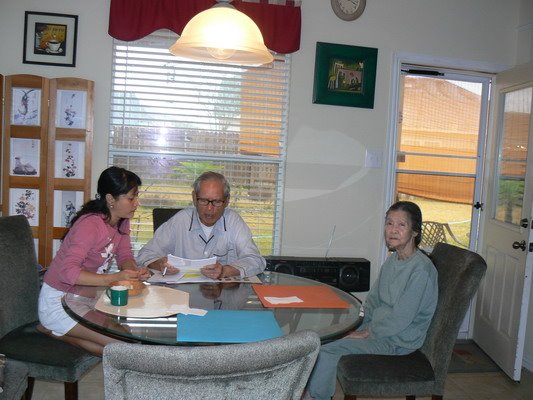Mar 3, 2014
BE LIKE A TREE - Preface
BE LIKE A TREE
Zen Talks by Thích Phước Tịnh
Edited and Illustrated by Karen Hilsberg
PREFACE
Traditionally, the practice of mindfulness has been taught in the context of a personal, long-term relationship between teacher and student, master and disciple. Most often, these relationships took place between and among monastics, although since the time of the Buddha over 2,500 years ago, the teachings were also made available to lay practitioners (also known as householders) such as Anathapindika. In this life, I have had the great good fortune to receive the teachings of such a teacher, the Venerable Thích Phước Tịnh, referred to often as “the Venerable.”
After spending most of his life in Vietnam, where he ordained as a monk as a young man, and where he became the abbot of a beautiful temple in Dalat, he came to live in Southern California. After spending his life in Vietnam and offering teachings to monastics and lay practitioners, he came to the West and began offering teachings in Vietnamese to monastic and lay practitioners in San Diego County, Orange County, Los Angeles County, and at Deer Park Monastery in Escondido where he currently resides. All of his talks are presented in his native tongue, and some are simultaneously translated into English. I remember the first dharma talks I attended in the small meditation hall in Solidity Hamlet in the summer and fall of 2003. I was impressed that the Venerable was such a masterful storyteller who could assemble a talk like a quilter assembles a quilt, laying all the patches down carefully and then sewing them together to make a whole that is much greater than the sum of its parts. As a labor of love, I have transcribed some of his talks by hand during the simultaneous translations and edited them into book form in order to share the dharma with English-speaking practitioners.
The Venerable and I came to know one another personally during a time of great crisis in my life, when my husband of fifteen years was dying of pancreatic cancer. The Venerable wrote us two very inspirational letters to help us through our difficulties. This is one of them:
We, the Easterners or Westerners, young or old, we are always very fearful when we are facing death. From the day that we are healthy to the moment that we are ill and our breath is irregular, we still don’t believe that we are facing death. Of course this physical body is disintegrating but we still don’t accept that. And that belief is deep in our consciousness. But there is an ultimate truth, and this is based on how deep our awareness is and how strongly you believe in your own self. Life is a cycle of manifestation, and death is a cycle of de-manifestation. But we are the awareness that is no-birth no-death.
Just like the trees in the winter time, the leaves fall and the branches are bare. But we cannot say that during that three-month period the tree is dead, because the living energy still exists. We know that in springtime the young shoots and new leaves will return fresh and develop very fast. Our human life is a miracle, and is a thousand times more miraculous than the trees during the changing.
If the tree uses the cycle of rest so that it can grow, human beings should look at the life and death of this physical body just like a cycle so that they can mature in the spiritual life. This is the reason that when you look deeply into your own mind you won’t have any worry, fear or despair.
And I myself am not a good practitioner, and I have many sufferings when I see that my loved ones are very sick and I cannot help them, and I have to face many of my friends leaving, and I do not have the power to hold them back.
But because of the practice eventually I can transform my fear and suffering in my heart. I have strong faith that our True Self is no-birth no-death, and life and death of this physical body is only a period of the manifestation and de-manifestation of this no-birth no-death of our True Self.
Bodhisattvas or Zen masters, they come to this world and they leave this world very peacefully and freely. They can say goodbye to this life with joy because they surely know that we are not forever gone. We are no different than these bodhisattvas or Zen masters. We need a strong belief in one thing, that this physical body is having illness and having pain and it is here and then gone, but our life, our True Self, or the awareness is never gone.
I sincerely hope that you have strong faith in your Buddha nature that is no-birth no-death, that is your True Self, so you can overcome despair, worry, sadness and suffering. And I pray that the Three Jewels of the Ten Directions will always protect you so that you will have strong faith in yourself.
Venerable Thích Phước Tịnh
(Translated from Vietnamese text by Vân Khánh Hà)
It is quite unusual for a Vietnamese monastic to visit the home of a Western lay practitioner. However, due the severity of my husband’s illness and the conditions being favorable, the Venerable compassionately accepted an invitation to visit our home in the spring of 2005. My husband was not well during the visit, and so the Venerable proceeded to offer guidance to me that proved extremely helpful in the ensuing weeks and months. He encouraged me to determine what kind of help I needed, to evaluate who could successfully provide that help, and to ask for and graciously accept the help offered. He watered my wholesome seeds, praised the resilience of women, and encouraged me to “Be like a tree,” which became a koan for me. He urged me to stay firmly rooted, even as the storm of my husband’s illness tossed around my branches and leaves. Over the years, I have pondered the question, “What does it mean to be like a tree?” After my husband’s death, I was inspired to return to painting, a passion from my earlier life, and I painted a number of trees as I explored this question in the context of my mindfulness practice. These paintings are included as illustrations in this book.
Two weeks before my husband’s death, my husband and I went to Deer Park Monastery and shared tea with the Venerable after his dharma talk (Life, Death, and Karma). I clearly remember the joy I felt listening to this wise Zen master as he encouraged my husband not to fight death but instead to make peace with himself and those around him.
This truth helped my husband and our family enormously, and I thought to myself, “How can I experience such happiness and freedom when my husband is dying?” I have come to believe that the answer is this: through clearly seeing reality as it was in that moment (i.e. that my husband was dying), rather than seeing it as I wanted it to be (i.e. that I wished my husband would not die), I felt the relief and bliss of the truth of the situation. And my understandings continue to grow as I am able to look at life and accept it (in the words of Fr. Thomas Keating) “just as it is in this moment without having to know all the details or trying to manipulate it.” That was a healing moment for me and continues to inform my way of living.
What it means to me now to be like a tree is to be myself, to be grounded, to bend with the weather but not to break, and to be a home and safe haven for others. Be like a tree also means to seek refuge: in nature, in the earth, the sun, the air, the rain and in reality as it is. Trees detoxify the air by taking in carbon dioxide and releasing oxygen for us to breathe. Trees have become my friends and teachers.
There are several appendices after the Zen talks. Appendix One is a biographical essay written by the Venerable after the passing of his dear friend Thầy Giác Thanh, the first abbot of Deer Park Monastery. Following his friend’s death, the Venerable was asked by our teacher Thích Nhất Hạnh to reside at Deer Park Monastery as the spiritual elder of the community. Appendix Two is a letter that was sent in a package of letters from our friends at Deer Park Monastery during the time of my husband’s illness. Appendix Three is an interview with the Venerable previously published in the Deer Park Breeze, a newsletter for the community. Appendix Four and Five are summaries of informal conversations between a small of students and the Venerable while enjoying Oolong tea in the room where he receives visitors at Deer Park Monastery.
I have been lucky to receive these life-changing teachings. I am grateful to the Venerable for his presence here in Southern California. For many years, his teachings have been available to the Vietnamese community in the form of compact discs, and a book of his teachings has been published in Vietnamese this year on the Forty-Two Chapters Sutra. The Venerable has dreamed of a book of talks in English, and it is my heartfelt aspiration to bring the Venerable’s beautiful teachings to English-speaking practitioners like myself. I transcribed these talks by hand as they were simultaneously translated from Vietnamese to English at Deer Park Monastery during Days of Mindfulness and retreats. I learned from my bilingual friends that the poetic nature of the Venerable’s talks is frequently lost in translation. I regret that even more may have been lost in my single-handed efforts to transcribe, interpret, and edit these talks. The Venerable asked me not to translate these talks verbatim, but rather to incorporate them into my life. From that perspective, he requested that I share my understanding of the dharma with my English-speaking friends.
I have done my best to be true to the intention of the teachings and to present them in a readable format based on my ever evolving understandings of the practice and the dharma. I accept full responsibility for the errors, lapses, inaccuracies and inconsistencies in the text.
Regarding the text itself, each chapter begins with a quotation from that talk which highlights the theme of the talk. Words in brackets indicate that they have been added for the purpose of clarification. My wish is that in spite of this highly imperfect process, the dharma will be clear and these teachings will help the reader to discover peace and reality as it is.
Karen Hilsberg
November 6, 2008
Subscribe to:
Post Comments (Atom)



No comments:
Post a Comment